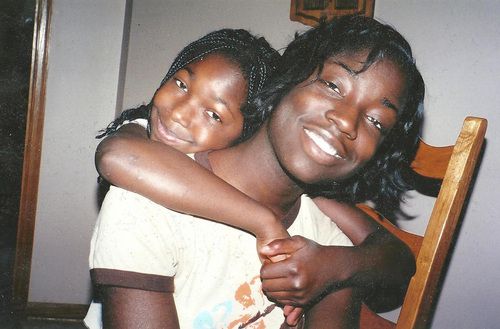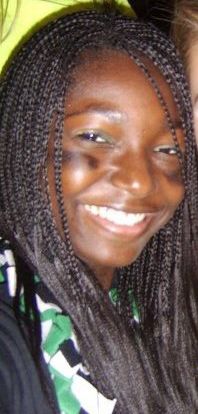
( Tinuola Olateju, left, with her big sister, Lola. Photo courtesy of Lola Olateju))
Two years ago, I wrote about several suicides in two area high schools. Because schools like to keep these things quiet — citing a fear of causing another one — I didn’t know the name of the 9th grader from North Oaks who took her own life at Mounds View.
I didn’t know she was in the student council, played basketball, ran track, loved to dance, and played the cello. Now I do.
 Her name was Tinuola Olateju, and she was Lola Olateju’s little sister.
Her name was Tinuola Olateju, and she was Lola Olateju’s little sister.
On Sunday, Lola’s “team” will join others at the “Walk Out of Darkness” event at Black Bear Crossing in Saint Paul’s Como Park, raising money for the American Foundation for Suicide Prevention, and calling more attention to a problem that too many people are ignoring. They’ll march in honor of Tinu, for whom Lola was a surrogate mother after their mother suffered a brain aneurysm. They’ll march in honor of Mitchell Pratt, another student at the school who took his own life.
Suicide leaves a lifetime of questions.
“I wonder what if she’d survived the attempt?” she told me on Thursday afternoon.
Those can be among the cruelest words in the aftermath of suicide. What if?
Lola’s former boyfriend died several years ago and she didn’t reveal to her sister or other members of the family that he’d killed himself. “I wonder what would have happened if I’d been more open about it?” she says.
There is, she says, no history of mental illness or suicide in the family. For Tinu, however, there was the stress of being a teenager in the ninth grade in Mounds View. “She texted me the night before and she was worried about her grades and school work and I texted back, ‘Oh sweetie, don’t worry, you’ll be OK; everything will be fine.'”
The next morning, Tinu was dead.
The school sent letters home with students and offered counseling to them, but otherwise kept a lid on information. It was the second suicide in the school that year; Tinu had mentioned the other one to Lola, she but didn’t seem to be particularly close to the other student, and she didn’t appear to be unusually affected by it. She just seemed to be a teenager.
Lola flew home to North Oaks from her job in Austin, Texas. Her best friend came to Minnesota to help bury Tinu, and write about the suicide of her friend’s sister. On the day of the funeral, it rained.
After Tinu’s body was lowered, the kids each took a turn shoveling some dirt into her grave. AAAAAHHHHHHHHH! I just can’t think about this right now. The image. The heartbreak. Sola sobbing. Peju holding him. Lola losing her mind for a moment. Kola stoic face. Every time I recall that, I’m on the verge of breaking down. But I can’t forget it either. I can’t forget the heartbreak that happens when despair causes you to take your own life. You take your own life and you take a bit of everyone’s heart and it gets buried down there too. When I have depressed days I must remember the sadness and heartbreak that happens if I don’t seek help and healing.
Shovels and Dirt and Graves also reminded me of Boneyard Prayer. If that ever reemerged, each night of the performance might just crack my heart beyond repair. There are clear images in that production of the gravediggers shoveling dirt to dig things up or to bury them. Shit, the opening scene of that play is the process of burying a baby. That is what we did in the real world on Saturday. We buried a baby and now the most intriguing show I’ve ever worked on hurts my heart to think about.
At one point Lola collapsed. I saw Brianna holding her head up to the sky letting the rain pour down her face. Drew’s girlfriend, Kelsey and I took turns literally holding Peju up. Sola just cried. We all just cried. We all stood around this family, this grave of a child and we couldn’t keep it together. How do I recover from this?
Lola went back to Texas. Eventually, her siblings went back to school. As what would have been Tinu’s 16th birthday approached in February 2011, she called the principal of the school in Mounds View to ask that a counselor check in with her brothers and her sister’s friends “to give them a heads up on a day that might be hard,” she said.
“They checked in once,” she said. “And that was it.”
Back in Texas, Lola didn’t do a lot of talking about what happened. She struggled for the correct answer to simple questions people would ask, like “how many siblings do you have?” She had to size up new acquaintances to determine just the right time to tell them she had a sister who killed herself. She had to explain to people who asked about the picture of the young girl in her cubicle. How do you work into a conversation that it’s your sister, and she’s dead?
When she heard co-workers talking about suicide and one said people who kill themselves “burn in hell,” she started talking more.
She’s back at work in Minnesota now. Some of her siblings don’t want to talk about what happened. Lola wants people to talk more openly about what’s happening to teenagers like her sister. She describes Sunday’s walk as “an action step.” She wants schools to be more open to discussing what’s happening. “You have a responsibility to take care of students in the midst of their seemingly-dire experiences,” she says.
It is a responsibility often going unmet. Schools pretend that students who kill themselves didn’t exist. They did. And still do.
“To people who have been through this, I say, ‘I see you. I know that it is not over. I understand,'” she said. To people who have never been through the suicide of a loved one, she says, “I do not wish it upon anyone. It is the most evil experience of all.”
“Check in with your family,” she advises. “If you see someone crying at work, you could walk past them. But you never know what can be prevented just by asking a question.”
Tinu’s classmates — she would have been a senior this year — still leave notes for her on a Facebook page. Lola Olateju has been to her sister’s grave twice; some family members have never been.
At some point after Sunday’s walk, however, they’ll choose a marker for Tinu’s grave.
“I think we’re ready,” she says.
